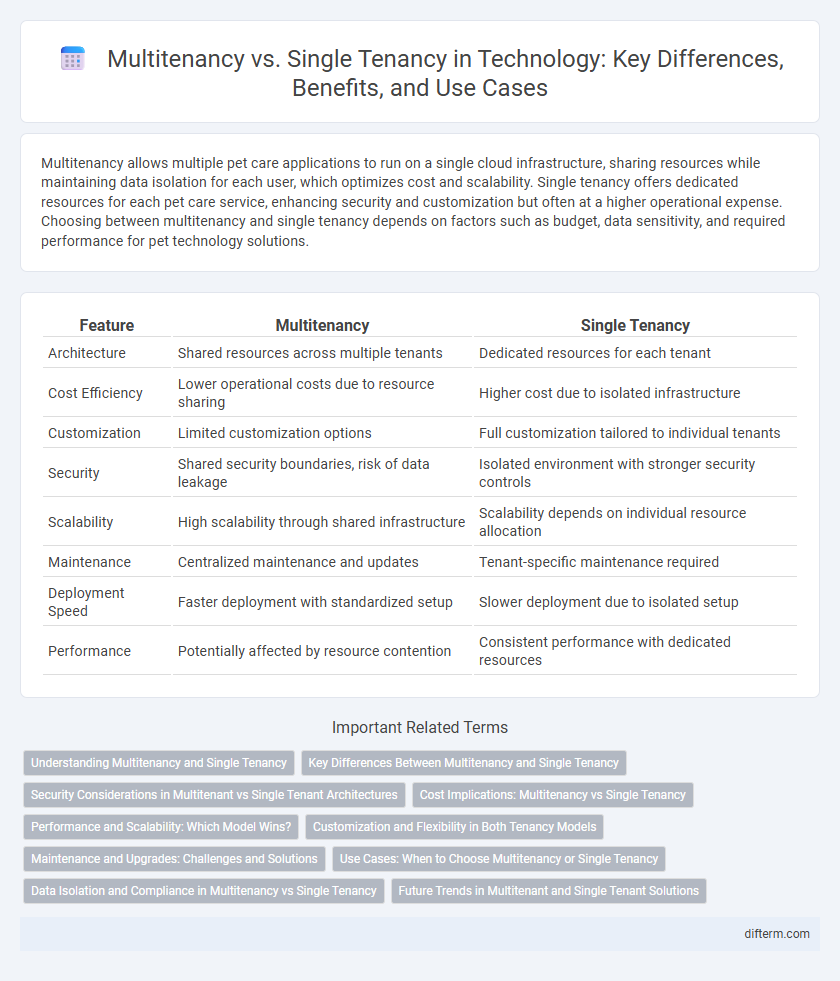Multitenancy allows multiple pet care applications to run on a single cloud infrastructure, sharing resources while maintaining data isolation for each user, which optimizes cost and scalability. Single tenancy offers dedicated resources for each pet care service, enhancing security and customization but often at a higher operational expense. Choosing between multitenancy and single tenancy depends on factors such as budget, data sensitivity, and required performance for pet technology solutions.
Table of Comparison
| Feature | Multitenancy | Single Tenancy |
|---|---|---|
| Architecture | Shared resources across multiple tenants | Dedicated resources for each tenant |
| Cost Efficiency | Lower operational costs due to resource sharing | Higher cost due to isolated infrastructure |
| Customization | Limited customization options | Full customization tailored to individual tenants |
| Security | Shared security boundaries, risk of data leakage | Isolated environment with stronger security controls |
| Scalability | High scalability through shared infrastructure | Scalability depends on individual resource allocation |
| Maintenance | Centralized maintenance and updates | Tenant-specific maintenance required |
| Deployment Speed | Faster deployment with standardized setup | Slower deployment due to isolated setup |
| Performance | Potentially affected by resource contention | Consistent performance with dedicated resources |
Understanding Multitenancy and Single Tenancy
Multitenancy architecture hosts multiple tenants on a single instance of software, optimizing resource efficiency while maintaining data isolation through logical separation. Single tenancy involves dedicated software instances for each tenant, enhancing customization and security at the cost of higher infrastructure and maintenance expenses. Understanding these models is essential for selecting scalable cloud solutions aligned with organizational needs and compliance requirements.
Key Differences Between Multitenancy and Single Tenancy
Multitenancy architecture hosts multiple customers on a single instance of software, maximizing resource efficiency and reducing operational costs, while single tenancy dedicates a unique instance to each customer, enhancing data isolation and customization. Security measures differ significantly; multitenancy requires stringent data partitioning protocols to ensure tenant segregation, whereas single tenancy inherently provides strong data security through physical or logical isolation. Scalability in multitenancy is more streamlined due to shared infrastructure, whereas single tenancy offers greater control over performance tuning tailored to individual tenant needs.
Security Considerations in Multitenant vs Single Tenant Architectures
Multitenant architectures share computing resources among multiple users, increasing the risk of data breaches due to potential cross-tenant vulnerabilities and requiring robust isolation mechanisms such as containerization and encryption. In contrast, single tenancy offers dedicated resources per user, enhancing security by minimizing exposure and allowing customized security controls aligned with specific compliance requirements. Effective identity and access management (IAM) and continuous monitoring are critical in both models to protect sensitive data and maintain regulatory adherence.
Cost Implications: Multitenancy vs Single Tenancy
Multitenancy significantly reduces cost implications by allowing multiple customers to share a single infrastructure, optimizing resource utilization and lowering operational expenses. Single tenancy often incurs higher costs due to dedicated hardware and increased maintenance requirements, resulting in greater capital expenditure. Organizations must evaluate their budget constraints and scalability needs when choosing between multitenant cost efficiency and single tenant control.
Performance and Scalability: Which Model Wins?
Multitenancy architecture maximizes resource efficiency by sharing infrastructure among multiple users, enhancing scalability and cost-effectiveness for cloud-based applications. Single tenancy offers dedicated resources per client, delivering superior performance consistency and security but may face limitations scaling due to higher infrastructure demands. Choosing between multitenancy and single tenancy depends on balancing performance needs with scalability goals, where multitenancy excels in elastic scalability and single tenancy provides predictable high performance.
Customization and Flexibility in Both Tenancy Models
Multitenancy offers limited customization since multiple users share the same application instance, making it ideal for standardized solutions with cost efficiency. Single tenancy provides extensive flexibility by allowing tailored configurations and isolated environments, enabling businesses to adapt software precisely to their unique needs. Companies prioritizing adaptability and specific feature sets often choose single tenancy despite higher costs for enhanced control.
Maintenance and Upgrades: Challenges and Solutions
Multitenancy architectures streamline maintenance by enabling simultaneous upgrades across all tenant environments, reducing downtime and operational costs. Single tenancy poses challenges with individualized maintenance windows and bespoke upgrade processes, increasing complexity and resource allocation. Implementing automated deployment tools and containerization can mitigate these challenges by standardizing update procedures and minimizing service interruptions in both models.
Use Cases: When to Choose Multitenancy or Single Tenancy
Multitenancy suits SaaS providers targeting diverse, cost-sensitive customers who need scalable, shared infrastructure for rapid deployment. Single tenancy is ideal for enterprises requiring enhanced security, data isolation, and custom compliance in industries like finance and healthcare. Choosing the right model depends on balancing cost efficiency, customization needs, and regulatory requirements specific to the use case.
Data Isolation and Compliance in Multitenancy vs Single Tenancy
Multitenancy offers shared infrastructure with logical data isolation, often relying on software-level controls to separate tenant data, which may pose challenges for strict compliance requirements like GDPR or HIPAA. Single tenancy ensures physical data isolation by dedicating hardware and resources to one tenant, enhancing security and simplifying adherence to regulatory standards. Organizations with stringent compliance needs often prefer single tenancy for its robust data isolation and control capabilities.
Future Trends in Multitenant and Single Tenant Solutions
Future trends in multitenant solutions emphasize enhanced scalability, AI-driven resource allocation, and robust security frameworks to support diverse user bases efficiently. Single tenant architectures are evolving with increased customization capabilities and isolated environments, appealing to industries with stringent compliance requirements. Advances in containerization and edge computing blur the lines between these models, offering hybrid solutions that balance performance and flexibility.
Multitenancy vs Single tenancy Infographic

 difterm.com
difterm.com